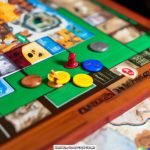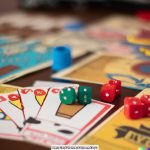Introduction
Card games and board games have been around for centuries, providing individuals and families a unique way to bond and connect through the power of play. Card and board games are a type of game played with specialized cards or pieces on a board game track. In the most basic sense, these types of games share one common goal – to build cooperation, community, and camaraderie among players. Additionally, it can help promote strategy, problem-solving skills, as well as tactical development.
The popularity of card and board games has become increasingly mainstream in recent years because they provide an entertaining distraction from everyday stressors for people of all ages. There are many different types of card and board games available today ” with classics such as Monopoly and Poker being updated yearly to provide new challenges with new rules, variations and twists in order to make them ever-changing yet likeable favorite’s year after year. More modern adaptations such as Settlers Of Catan or Clue, which has gone from tabletop version into video game version all the way up to online versions have created lasting impact in the industry within younger generations who now have more access than ever before. Some card & board games allow players hours upon hours of enjoyment; some encourage competition between friends offering bragging rights for those victorious; while others facilitate collaborative entertainment developing friendship bonds along the way which therefore hinting to further tactics utilize understanding human behavior & building relationships around shared interests.
History of Card and Board Games
Card and board games have played an integral part in both entertainment and education since ancient times. Evidence of playing cards has been found in China, Egypt, India, Persia and Rome dating back to the 9th century. According to many sources, modern card decks may have originated in a game called ‘Mamluk’ developed for the imperial court of the Mamluk dynasty in Egypt. The Mamluk game was made up of five suits depicting polo sticks, coins, cups, swords and strings of cash.
The Ancient Chinese were also playing a game involving printed paper after 618CE that developed into something resembling trading cards (see Go). This evolved into domino cards used for gambling during the Tang Dynasty (618-906AD), which then morphed into four-suited decks with different colored backgrounds for each suit. It is believed that these four-suited card decks spread throughout Asia and eventually reached Europe where they became generally accepted as gaming equipment around 1377AD.
Board games such as chess and checkers trace their humble beginnings back to India before spreading to China by 650AD, Japan by 770AD and Europe between 1000 AD – 1300 AD. Despite early references to such games in literature dating all the way back to 680BCE in Homer’s Odyssey and 1400 BCE in Mesopotamian inscriptions carved on tablets unearthed near present day Iraq; it is still uncertain exactly when these popular board games were invented or by whom. Traditional board games such as Snakes & Ladders first appeared from medieval times onwards. Its ancestor ” known more famously today as Chutes & Ladders ” was created by an Indian philosopher named Gyandev at some point between the 11th-13th centuries CE; inspired by teaching about life decisions leading people up or down paths of good or bad karma depending on their choices along their spiritual journey.
Over time card games continued evolving alongside advances in printing technology while board games were being overhauled with more complex rules added through to Victorian times when Lionel Wheatley invented Ludo (1896). Fast forward another hundred years or so later enterprising toy companies launched Trivial Pursuit (1979) and Cluedo (1949) to mix elements ofboard game with trivia whilst simultaneously rejuvenating classic genres too; forever revising them per growing societal preferences over time much like industrial revolutions tend to do..
Benefits of Playing Card and Board Games
Physical Health:
Playing card and board games can help to provide physical activity and burn calories. It is a great way to engage your body while spending time with friends or family. Playing card and board games can also improve hand-eye coordination, reflexes, concentration and agility. Games like chess require players to think strategically; table tennis and darts require good aim and accuracy when aiming for the game elements. All these activities can help with physical health by exercising the muscles of the hand, arms, legs, eyes, ears and intellect.
Mental Health:
Card and board games can help boost mental development because they contain established rules and strategies that must be understood in order to both win the game as well as plan how to beat your opponents. This encourages the development of logic skills ” especially in young children ” which helps strengthen cognitive abilities such as problem solving and logical thinking. They also enable us to have an outlet for our creative ideas while curing boredom during slow moments in life.
Social Health:
Playing card and board games are a great way to socialize without having to leave home. It brings people together through cooperative play, allowing them share stories, jokes and laughter while developing greater connections with peers or relatives. Whether it’s playing with a Wii or an Xbox Kinect or simply breaking out an old classic like monopoly, a friendly game shared by many can bring lots of fun into people’s lives while reinforcing positive relationships between them at the same time.
Popular Card and Board Games
Card games are usually played with a deck of cards and can range from one player to multiple players. Popular card games include bridge, poker, spades, and solitaire. Bridge is a four-player game that requires two teams. Players will bid on tricks each round and aim to win more tricks than their opponents. Poker is often played with up to eight or ten players who will compete against each other by building the strongest hand of five cards. Spades is also a four-player game where each team competes against each other in trying to take the most number of tricks in a round. Lastly, solitaire is often seen as an individual card game where the player’s goal is to lay all the cards down on separate piles according to suit and rank until there are no cards left in their hand or the board.
Board games often use dice or spinners; they usually require set up before playing, such as laying out pieces or constructing a three-dimensional layout. One popular board game today is Monopoly, which requires each player to collect properties as they make their way around the game board. Another popular board game is Scrabble, which involves players attempting to spell words using lettered tiles for points; extra points are awarded for landing words on special squares on the board.
Educational Aspects of Card and Board Games
Playing card and board games can have numerous educational benefits for children. Card and board games rely on strategy and reasoning, which can help improve problem-solving skills in learners of all ages. They challenge the individual to reason with different scenarios, as well as think ahead of their opponent or partner. They also require careful observation and attention to detail, leading to better memory, focus and cognitive development.
Math skills are improved due to the challenges that card and board games bring in working out possible moves using numeracy skills and probabilities. Language skills is another major area that can be enhanced when playing these kinds of games, such as reading comprehension through analyzing directions or understanding vocabulary words related to the game being played. Through creating rules commonsense reasoning is encouraged which promotes critical thinking in developing higher order thinking skills.
Above all these advances activities should be seen as a form of leisure activity allowing children to enjoy themselves while still promoting a sense of strategic handling which makes them more competitive in other areas of life.
Tips for Creating Your Own Card and Board Games
When creating your own card and board games, it is important to have a plan and strategy for the development of your game. Start by coming up with an idea for the game, perhaps one that deals with certain themes or topics that you find interesting. It can also help to think about favorite experiences from playing classic games, such as Monopoly or Scrabble, when coming up with ideas for your own game.
Once you have settled on an idea for the game, start brainstorming all of the elements needed to make it work. Determine how many players that can participate and what type of cards would be included in the set. Decide whether or not it will require a board and if there are any special rules associated with winning or losing, such as points awarded per round or number of turns before the game ends. Additionally, think about whether there will be any special items (such as coins, dice or spinners) used by players during the game play.
At this point you will want to begin working on designs and layouts for both your cards and board if necessary. Keep in mind that colors should coordinate well together so that they are attention grabbing and interesting during gameplay. When deciding on packaging consider finding something clear but attractive enough demonstrate what type of game is inside while maintaining its integrity after opening it up. Lastly consider adding some extras such as taking offers from local businesses to include coupons in each package which could become a great method of earning extra income from their sale.
Conclusion
Card and board games are an integral part of society, offering a variety of social, physical, mental and cultural benefits. They provide an opportunity for people to interact and create meaningful relationships with one another. Beyond that, they can help to develop cognitive abilities, increase hand-eye coordination and foster problem-solving skills. In addition to these learning benefits, playing card and board games can also serve as a form of stress relief or relaxation. Playing games together is the perfect way to spend quality time with family or friends while having fun. Card and board games are an accessible pastime; there is a game out there for everyone regardless of their skill level or experience. As such, card and board games hold an important place in modern society; providing enjoyment as well as educational value for all involved.

I love playing all kinds of games – from classics like Monopoly to modern favourites like Ticket to Ride.
I created this blog as a way to share my love of board games with others, and provide information on the latest releases and news in the industry.





